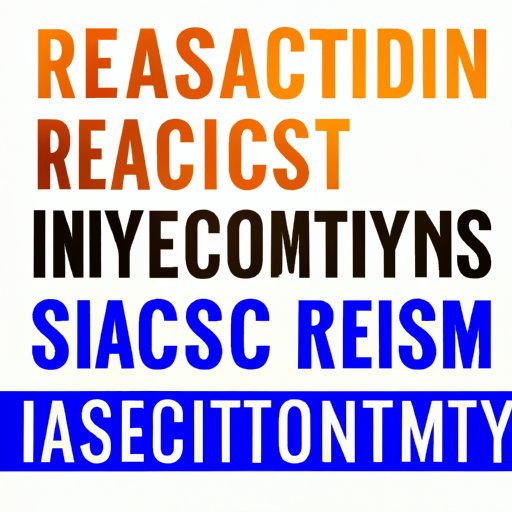
Introduction
Discussions around systemic racism, particularly those that occur within the realm of education, have gained significant attention in recent times. It has become apparent that the persistent and pervasive nature of racism in society, coupled with systemic biases deeply embedded in our educational institutions, contribute to disparities in student outcomes along racial lines. To address this issue, it is important to understand exactly what systemic racism is, and how it manifests in education.
Exploring the Foundations of Systemic Racism in Education
Systemic racism refers to the set of institutional policies, practices, and procedures that perpetuate discrimination and inequality along racial lines. In the context of education, this can manifest in several ways. It can be seen in the unequal distribution of resources among schools, such that schools in marginalized neighborhoods typically have fewer resources available to them than schools located in affluent areas. Systemic racism can also be seen in the ways in which school policies and practices often have a disproportionate negative impact on students of color. One example of this is the over-reliance on disciplinary measures and the disproportionate punishment of black and brown students.
It is important to note that systemic racism is different from individual acts of racism. While individual acts of racism involve prejudice and discrimination at the personal level, systemic racism operates invisibly at the structural level, and often without conscious intent from those that perpetuate it.

The Long Reach of Systemic Racism: Educational Disparities in Black and Brown Communities
The impact of systemic racism on education is particularly severe for students of color, particularly black and brown students. Black and brown students are often disproportionately impacted by issues such as high dropout rates, lower test scores, and lower graduation rates. A study released by the National Center for Education Statistics in 2018 found that only 66% of black students and 75% of Hispanic students graduated in four years, compared to 88% of white students. Similarly, only 27% of black students and 32% of Hispanic students achieved proficiency on the National Assessment of Educational Progress (NAEP) exam, compared to 51% of white students.
From Policy to Practice: Deconstructing the Impact of Systemic Racism on Education
One of the reasons that systemic racism in education persists is because it is often embedded in policies that have been in place for a long time. For example, school funding sources that are tied to property values often ensure that wealthy neighborhoods receive more significant school funding than poorer ones. This uneven distribution of resources perpetuates the cycle of poverty and leaves students from marginalized communities at a disadvantage. Similarly, policies such as the zero-tolerance policy in schools disproportionately affects students of color, leading to higher rates of suspension, expulsion, and arrest, which translates into lower graduation rates.
Breaking Down the Invisible Barriers: Understanding Systemic Racism in the Classroom
It is essential to recognize that systemic racism is not limited to policies and institutional practices. Classroom interactions can also perpetuate systemic racism and lead to discrimination against marginalized groups. One example of this is the idea of implicit bias – unconscious attitudes or prejudices that can lead to discriminatory behavior. In the classroom, implicit bias can manifest in the form of lower expectations for students of color or stereotypical assumptions. Teachers might unconsciously treat students of different races differently, leading to differences in educational outcomes.
Illuminating the Hidden Structures of Racism in Education: An Examination of Power Dynamics that Perpetuate Injustice
Power dynamics play an integral role in the perpetuation of systemic racism within educational spaces. Certain groups – specifically those in a position of power, such as administrators and educators – have the ability to influence policies, funding, and decision-making that impact marginalized communities. However, individuals from marginalized communities often lack representation and are not able to advocate for their needs within educational spaces. For instance, a lack of diversity among administrators and faculty can make it more challenging for students of color to access the same education as their white counterparts.
Dismantling Systemic Racism in Education: A Call to Action for Institutions and Individuals
In order to address systemic racism in education, there needs to be a concerted effort on the part of institutions and individuals. This can include policies that promote diversity among faculty and administrators and prioritize resources to underrepresented communities. It also means recognizing what implicit biases may be present in classrooms and taking active steps to address them. Educators need to be aware of how their decisions and actions may affect students from marginalized communities, and be willing to create a more inclusive and equitable learning environment.
Systemic Racism in Education: Why Silence and Inaction are not Solutions
It is important to recognize that silence and inaction in the face of systemic racism effectively reinforce the very system that perpetuates inequality. It is not enough to condemn individual acts of racism; meaningful changes must happen at the institutional level. In order to create a more equitable educational system, we must be willing to confront and dismantle systemic racism, which means recognizing that it is a problem that affects us all.
Conclusion
The issue of systemic racism within education is multifaceted and complex, requiring a sustained effort from a multitude of stakeholders. It is important to recognize the ways in which systemic racism operates invisibly within our educational system, and to identify actionable steps that can be taken to promote a more equitable and inclusive learning environment. By doing so, we can help bridge the gap between educational outcomes and ensure that all students, regardless of their race or ethnicity, have access to the opportunities and resources they need to succeed.




